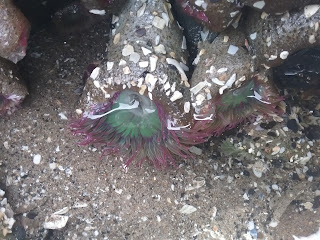Watch Out Prey - They Sting!
Alan Quimby was the lead interpreter on the beach on May 16, 2016 and spied an Aggregating Anemone (Anthopleura elegantissima) and a Shore Crab in close proximity in the tidepools.
The aggregating anemone is an invertebrates that looks likes a flower, with a tube shaped body capped by tentacles. Colored anemones have algae living in their tissue in a symbiotic relationship. The anemone bends away or toward the light to facilitate the light level needed for photosynthesis in the algae; it return, the algae provides food to the anemone.
Anemones eat a wide variety of food, using stinging cells on their tentacles (called nematocysts) to paralyze their prey. They can even ingest small crabs and discard the shells. Perhaps that is what happened to the shore crab on this day as the crab must have gotten a little too close and appeared to have been paralyzed by a small aggregating anemone.
The anemone is abundant on the rocky shore and can almost always be seen in the tidepools at Haystack Rock. If you have visited Haystack Rock multiple times, you have probably noticed that the sand can drift from week to week and even from day to day. The anemone can easily be buried by the drifting sand but can survive up to 3 months under the sand.
Anemones retract their tentacles when they are exposed to the air. Sand and bits of shell cling to sticky bumps on their body which provide both camouflage and protection from drying out. The anemone is less apparent in this state, frequently blending into the rocks to which they are adhered.
Next time you are at the rock, take an opportunity to admire the 'flowers' of the tidepool. The beach season at Haystack Rock has now started and we look forward to seeing you on the beach!
The aggregating anemone is an invertebrates that looks likes a flower, with a tube shaped body capped by tentacles. Colored anemones have algae living in their tissue in a symbiotic relationship. The anemone bends away or toward the light to facilitate the light level needed for photosynthesis in the algae; it return, the algae provides food to the anemone.
Aggregating Anemone
Paralyzed Shore Crab
Anemones retract their tentacles when they are exposed to the air. Sand and bits of shell cling to sticky bumps on their body which provide both camouflage and protection from drying out. The anemone is less apparent in this state, frequently blending into the rocks to which they are adhered.
Aggregating Anemone






Comments
Post a Comment